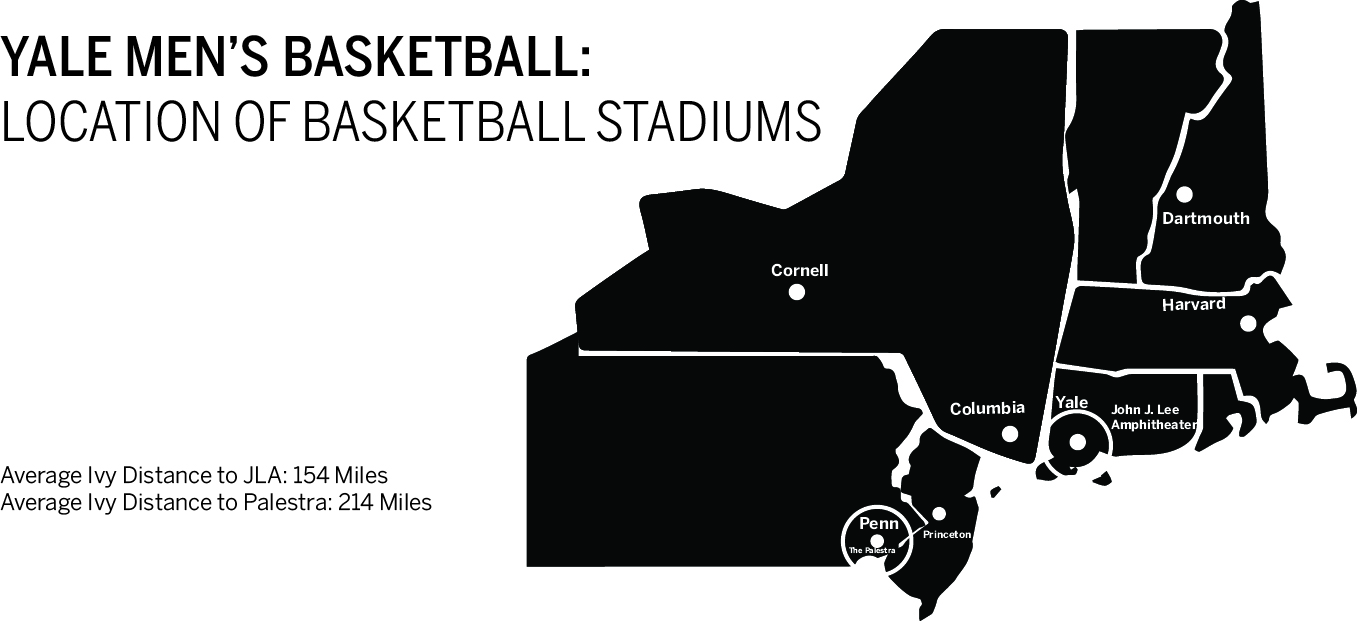
Designed by Andre Costa
The Ivy League announced in May that Yale’s John J. Lee Amphitheater would host this season’s Ivy Madness, the postseason four-team playoffs that determine the Ivy League’s automatic bids to the men’s and women’s NCAA Tournaments. From the moment the conference announced the move, debate has swirled on whether the conference made the right decision, and with basketball season now in full swing, we can expect the discussion to get even more heated.
Since its inception in 2017, Ivy Madness had been hosted at the Palestra on Penn’s campus, and Quaker fans have been particularly irate about the move away from Philadelphia. Hours after the Ivy League announced the decision, a columnist in The Daily Pennsylvanian called the move the Ivy League’s “terrible, horrible, no good, very bad decision.” Former Penn captain Darnell Foreman tweeted: “The league can’t be serious. Next [Ivy Madness is] gonna be [held in] a random rec gym.”
Penn fans are upset that the home-court advantage they enjoyed each of the last two years is gone, but let’s be clear, the Ivy League made the right decision to move the tournament from the Palestra to the Lee Amphitheater for 2019.
The argument for playing the tournament at Yale is based on the following realities. First, the Palestra has enough flaws that it is worth exploring another option before committing to Philadelphia for the next 10 years. Second, the Lee Amphitheater is the best of all the remaining options.
Although the Palestra is one of the nation’s most historic gymnasiums, it is not a perfect fit for Ivy Madness. It creates an unfair home-court advantage for Penn and to some degree Princeton. In each of the last two years, the arena has been filled with partisan Philadelphians and Princeton fans who made the 40-minute trek south. Quaker players also have the luxury of sleeping in their own beds and playing on a familiar floor.
The home-court advantage has undoubtedly affected the outcome of the tournament. Through two years, Penn’s and Princeton’s men’s and women’s basketball teams are undefeated in Ivy Madness against the other six schools.
Of course, picking any Ancient Eight member to host would create this problem, but the Palestra poses a particular challenge that the Lee Amphitheater does not. The fact that Penn is not centrally located within the conference magnifies the Quakers’ home-court advantage. Penn is the southernmost Ivy, and the other seven Ivies are an average of 214 miles away from the Palestra. Location matters, and putting the tournament in Philadelphia poses a serious disadvantage to the New England Ivies and their fan bases.
Meanwhile, New Haven is arguably the geographic center of the Ivy League. The other seven schools are located a mere average of 154 miles from the Elm City, which means that a tournament in the Lee Amphitheater would give the Bulldogs less of a home-court advantage than the one the Quakers have enjoyed for the past two seasons.
Size is also a disadvantage for the Palestra. While the Penn-Princeton men’s semifinal from 2017 nearly packed the 9,000-seat Palestra, most games since have been played in a half-empty gym. No matter how iconic the Palestra is, thousands of empty seats have killed the energy for some of Ivy Madness’ most exciting games.
Although the Palestra may inevitably be the right arena to host Ivy Madness, the conference should consider the alternatives. Everyone knows that you don’t buy the first car you test-drive or the first house you tour without checking out your other options. The Ivy League has the opportunity to create something special with Ivy Madness. It’s worth trying something new for 2019 to make sure the conference gets it right before signing a long-term deal with the Palestra.
Of the other options available, the Lee Amphitheater is the best bet. It had been rumored that the Ivy League was considering moving the tournament to a neutral site like St. John’s Carnesecca Arena or Boston College’s Conte Forum. While these arenas offer prime location in major cities, picking a neutral site would go against the brand that the conference goes to great lengths to curate. The Ivy League is known for tradition, academic reputation and ivory towers. Since no one does those things better than its member schools, Ivy Madness needs to be hosted in one of their campuses.
When the ESPN broadcast returns from commercial breaks this year, viewers will see images of Harkness Tower and Sterling Memorial Library before diving back into the action on the hardwood. That’s what the league wants and what grows its brand. The prestige of the Ivy League, not the history of the Palestra or Carnesecca Arena, is what keeps alumni engaged and makes recruits want to play in the Ancient Eight.
Payne Whitney Gymnasium — nicknamed the “Cathedral of Sweat” — gives the conference both a historic setting and a central location. Many of the other Ivy arenas boast one of those things, but not both.
But besides Yale’s architecture and New Haven’s proximity to major cities, the Lee Amphitheater is a great venue for basketball. With all 2,500 seats filled, as they will be for every session of Ivy Madness, the Lee Amphitheater echoes like no other venue I’ve visited in my life. Just last year, Yale renovated the Lee Amphitheater’s locker rooms, which are substantially bigger than the Lanman-Wright Hall-sized changing rooms in the Palestra. The Lee Amphitheater also provides spectators with seats, as opposed to the rickety benches of the Philadelphia venue.
Even if it’s just for 2019, bringing Ivy Madness to New Haven is worth it.
Matthew Mister | matthew.mister@yale.edu







